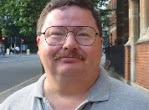South Texas Writing Project release
Note: The following is a feature-style press release I wrote for the South Texas Writing Project.
By The South Texas Writing Project
Word play-based sensory stimulation, designed to awaken sleeping creativity within, engulf student writers and writing instructors in each gathering of the South Texas Writing Project.
South Texas Writing Project events aim to stimulate dormant, or fatigued, writing skills through word games and writing exercises. Current STWP events include a fall conference for students and instructors, and gets instructors together in a summer session at Texas A&M International University. The STWP is the local chapter of the National Writing Project.
STWP events are frequently led by national-level writing instruction gurus such as Bruce Ballenger who flew in from Boise, Idaho in October for the fall conference where he guided some 100 students through self-improvement steps before helping around 40 writing instructors see their creative thinking potential through word-building and language use exercises.
Ballenger, an English professor at Boise State, and author of several writing-related books, was impressed by the local students he worked with shortly after arriving.
“I’ll never forget what I witnessed that night. No matter what the writing prompt, 100 mostly Hispanic students enthusiastically picked up their pens and filled blank pages with writing,” Ballenger said by e-mail. “And they wanted to talk about it.
“I’m not sure I’ve ever had a more receptive student audience. These students were hungry to write and talk about writing.”
Ballenger’s lively connection with Laredo-area students didn’t stop there. The stimulation demonstrated by the students left a high water mark in his mind.
“They seemed to appreciate, more quickly than other students I’ve taught, how powerful writing can be as a method of discovery, a way of organizing and even attaching meanings to their experiences,” Ballenger said. “When I showed them the door through expressive writing they seemed excited about going through it. In the last year or so, I’ve traveled to about 30 campuses across the U.S. to talk about writing and teaching writing, but my visit to Laredo was one of the more extraordinary experiences I’ve had.”
Parents and writing educators share hope that one, or more, of their charges might eventually write great novels and achieve literary greatness, but the writing project hasn’t given up on their mentors, either. Writing project leaders also see writing teachers being better at their jobs by working to become better writers, too.
STWP Director Bernice Sanchez-Perez notes the project’s aims are inclusive, seeking to raise the capabilities of the area’s writers, and would-be writers.
“The overall goals of the STWP are to continue to build communities of writers within the college, public schools, and private school communities,” Sanchez-Perez said. “One of the main goals of the STWP is to provide professional development opportunities in order to enhance the teaching of writing. We are seeing larger numbers of elementary teachers wanting to get involved in the STWP.”
Sanchez-Perez added that STWP plans to continue to bring in motivational speakers of Ballenger’s level who will bring in effective strategies and new methods to teach writing.
Ballenger’s second day session with writing instructors from Laredo elementary through university campuses focused on inquiry-based approaches that address TEKS mandates, requiring students to develop a research plan that addresses open-ended research questions. The session included issues of self-improvement perspectives, using much of the same thinking that went into “The Curious Researcher,” one of his several books.
Ballenger and the instructors examined the qualities of a good question, research patterns, extending the open inquiry process, and several points he trusts when seeking information.
“There are no boring topics, only boring questions,” Ballenger said. “Suspend judgment and tolerate ambiguity.
“Questions are like knives. Research writing is wrestling.”
Second day morning and afternoon sessions divided writing instructors between the elementary, middle, and high school levels with instruction focusing on becoming a better writer through reading; multi-author story writing, word choice and sentence fluency; mini-lessons in sentence construction; reading and writing across the curriculum. Powerful photos from the Holocaust added emotion, and the senses to a lesson connecting reading and writing to history, politics, psychology, and life experiences with knowledge gained on the topic.
Several of the lessons involved free writing, in which participants write non-stop for several minutes, using their memory with smell, sight, hearing, and taste.
Mike McIlvain
Labels: press release

